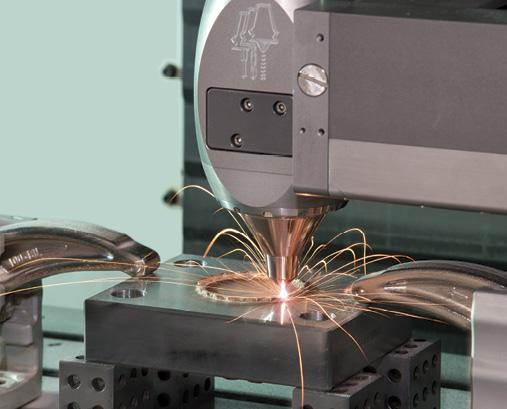Attendees at the IMTS 2016 trade show may have noticed a number of magnetic “hybrid” signs affixed to several brands of machine tools. The man largely responsible for the signs being displayed is Jason Jones, inventor of the AMBIT laser cladding head and co-founder of Hybrid Manufacturing Technologies Inc., Plano, Texas.
The result of nearly a decade of R&D, the AMBIT might be mistaken for a newfangled style of toolholder, but it’s a laser-equipped deposition head, one that’s able to convert virtually any CNC machining center or multitask lathe into a machine tool capable of both additive and subtractive manufacturing.


Hybrid Manufacturing Technologies’ AMBIT laser cladding head can repair parts or build them “from scratch.” Image courtesy Hybrid Manufacturing Technologies.

The system has two parts. The head itself fits in a spindle, turret or robotic gripper and can be equipped with a number of mounting options, most of which are compatible with an automatic toolchanger. The second part is a machine-mounted docking station that feeds metal powder and supplies laser power and shielding gas to the head. Multiple heads and powders can be used in a single machine, making it possible to perform a variety of work in a single setup.
In operation, a controlled stream of metal powder is sprayed towards the workpiece while the laser simultaneously melts the powder, fusing it to a part surface. Multiple layers can be deposited and then subsequently machined as needed to improve accuracy and surface finish of the cladded area. This makes the head ideal for repairing components, although Jones pointed out that hard facing and adding features to existing parts are also key capabilities.
“It was exciting to be with Mazak at their booth again this year, as we were during the JIMTOF 2014,” Jones said. “The AMBIT was used for the first time this year on one of Mazak’s Kentucky-built machines, the VC500AM. Additionally, in the Mitsui Seiki booth, we were showing our latest lineup of the Series 7 head, which is a refined version of a previous generation, but more compact and made of titanium to reduce weight.”
Hybrid Manufacturing was also at the ELB booth, showcasing what Jones said “is probably the only hybrid grinding product on the market.”
In addition, he hinted at the introduction of an inspection head that will allow users to probe for surface and subsurface cracks in workpieces. “We have a couple of early adopters that will take delivery of it late this year and early next,” Jones said, adding that there probably will be another 6 or 7 months of refinements before it becomes a more- mainstream product.
Related Glossary Terms
- automatic toolchanger
automatic toolchanger
Mechanism typically included in a machining center that, on the appropriate command, removes one cutting tool from the spindle nose and replaces it with another. The changer restores the used tool to the magazine and selects and withdraws the next desired tool from the storage magazine. The changer is controlled by a set of prerecorded/predetermined instructions associated with the part(s) to be produced.
- computer numerical control ( CNC)
computer numerical control ( CNC)
Microprocessor-based controller dedicated to a machine tool that permits the creation or modification of parts. Programmed numerical control activates the machine’s servos and spindle drives and controls the various machining operations. See DNC, direct numerical control; NC, numerical control.
- grinding
grinding
Machining operation in which material is removed from the workpiece by a powered abrasive wheel, stone, belt, paste, sheet, compound, slurry, etc. Takes various forms: surface grinding (creates flat and/or squared surfaces); cylindrical grinding (for external cylindrical and tapered shapes, fillets, undercuts, etc.); centerless grinding; chamfering; thread and form grinding; tool and cutter grinding; offhand grinding; lapping and polishing (grinding with extremely fine grits to create ultrasmooth surfaces); honing; and disc grinding.
- lapping compound( powder)
lapping compound( powder)
Light, abrasive material used for finishing a surface.
- lathe
lathe
Turning machine capable of sawing, milling, grinding, gear-cutting, drilling, reaming, boring, threading, facing, chamfering, grooving, knurling, spinning, parting, necking, taper-cutting, and cam- and eccentric-cutting, as well as step- and straight-turning. Comes in a variety of forms, ranging from manual to semiautomatic to fully automatic, with major types being engine lathes, turning and contouring lathes, turret lathes and numerical-control lathes. The engine lathe consists of a headstock and spindle, tailstock, bed, carriage (complete with apron) and cross slides. Features include gear- (speed) and feed-selector levers, toolpost, compound rest, lead screw and reversing lead screw, threading dial and rapid-traverse lever. Special lathe types include through-the-spindle, camshaft and crankshaft, brake drum and rotor, spinning and gun-barrel machines. Toolroom and bench lathes are used for precision work; the former for tool-and-die work and similar tasks, the latter for small workpieces (instruments, watches), normally without a power feed. Models are typically designated according to their “swing,” or the largest-diameter workpiece that can be rotated; bed length, or the distance between centers; and horsepower generated. See turning machine.
- machining center
machining center
CNC machine tool capable of drilling, reaming, tapping, milling and boring. Normally comes with an automatic toolchanger. See automatic toolchanger.
- toolchanger
toolchanger
Carriage or drum attached to a machining center that holds tools until needed; when a tool is needed, the toolchanger inserts the tool into the machine spindle. See automatic toolchanger.
- toolholder
toolholder
Secures a cutting tool during a machining operation. Basic types include block, cartridge, chuck, collet, fixed, modular, quick-change and rotating.

